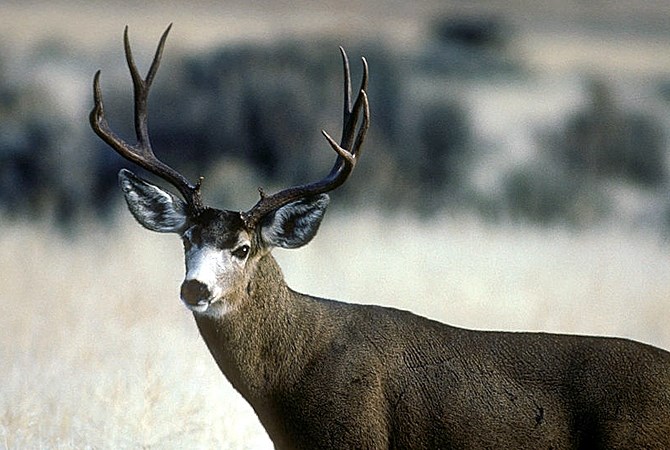
A four-point Mule deer.
Image Credit: commons.wikimedia.org
November 12, 2023 - 7:00 AM
As the rut season continues, the Okanagan is likely to see an influx of beautiful bucks strutting across lawns in search of a mate.
But there are number of risks that come with this striking natural display.
Adam Ford, Professor for the Okanagan Institute for Biodiversity, Resilience and Ecosystems Service, told iNFOnews.ca deer are becoming less afraid of people, which could turn into a big issue.
“We have to make sure that these animals aren't being habituated to us and we're taking responsible care to give them space and let them carry out their natural activities,” Ford said.
“This time of year, for a few days at a time, adult female deer, which are called does, (will) come into estrus. They give off pheromones into the air and the male deer pick up on that and that triggers their sort of pursuit behaviour. The males will be moving around the forest, trying to find these estrus females. And that brings them into contact with people in a different way where they'll be moving around all day long and in the night as well. Whereas, during the rest of the year, especially white-tailed deer, usually are a bit more secretive and less active during the day when people are out on the hiking trails.”
Male deer may also be more territorial during this time, fighting with other males to assert their dominance.
This behaviour can put the deer themselves at risk of death. Ford said that scientific studies on elk have shown the males can get a little too overzealous at this time of year, limiting their survival chances.
“After the rut, some of these animals can be pretty exhausted,” Ford said, “And if there's not enough food around or if they've overexerted themselves, they may perish at that point.”
However, male deer can be quite aloof and difficult to study. Generally, Ford said, ungulate ecology likes to focus on the females and the young.
“(Male deer are) really tricky to study in the conventional way, which is fitting them with these GPS collars around their neck,” Ford said.
During the rut, the male's necks will significantly swell because of the higher levels of testosterone in their system. This makes fitting the collars virtually impossible.
These hopped up, testosterone-filled animals don’t typically attack people. However, it’s still always a good idea to avoid feeding them, according to Ford.
“It's a nice thought that we can coexist that way, but not everybody acts the same,” Ford said. “Sometimes animals read the situation differently… if an animal sees a dog and feels threatened, it might act differently. Even if someone's built up a relationship with that specific individual.”
Being too close to wild deer also poses the risk of disease transmission, even Covid.
“There's been evidence of white-tailed deer being reservoirs for COVID-19,” Ford said, “It's hard to know how they picked it up, but maybe, if people are sharing apples (with wild deer) … then there's like a spillover effect where these animals might be a reservoir where COVID mutates and then re-enters the human population in a worse way.”
Then there are known diseases, called zoonoses, that can be transmitted between human animals, such as Lyme disease.
“One that people are quite concerned about in Alberta or everywhere is called chronic wasting disease, which is a prion disease,” Ford said. “Prions are like malformed proteins, they're not like a virus… It's just like a bad copy of a protein, but it somehow can replicate itself, which is really spooky. And they can persist in the environment.”
“They can be present in urine and saliva and it causes starvation 100% of the time and early death of these animals,” he said. "It's basically the same type of disease… as mad cow and other scurvies... there's widespread concern that once that enters the human food chain, it's going to be a huge problem.”
Ford said this disease has been spreading across North America and is currently on British Columbia’s doorstep.
“Usually the deer are smarter than that and they see us move or smell us and they take off,” Ford said. “But that's the thing. If a deer are exposed to human activity a lot, they won't have that aversive response. So they might just get too close. And who knows?”
To contact a reporter for this story, email Georgina Whitehouse or call 250-864-7494 or email the editor. You can also submit photos, videos or news tips to the newsroom and be entered to win a monthly prize draw.
We welcome your comments and opinions on our stories but play nice. We won't censor or delete comments unless they contain off-topic statements or links, unnecessary vulgarity, false facts, spam or obviously fake profiles. If you have any concerns about what you see in comments, email the editor in the link above. SUBSCRIBE to our awesome newsletter here.
News from © iNFOnews, 2023